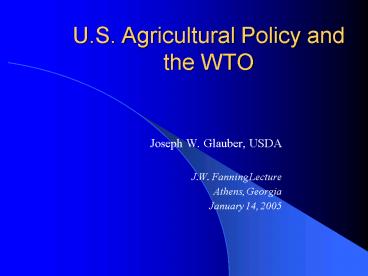U.S. Agricultural Policy and the WTO - PowerPoint PPT Presentation
1 / 31
Title:
U.S. Agricultural Policy and the WTO
Description:
1998-01 'emergency' legislation; rise in amber box outlays ... Amber: most trade distorting. Under URAA, total amber support reduced by 20% from 1986-88 levels ... – PowerPoint PPT presentation
Number of Views:73
Avg rating:3.0/5.0
Title: U.S. Agricultural Policy and the WTO
1
U.S. Agricultural Policy and the WTO
- Joseph W. Glauber, USDA
- J.W. Fanning Lecture
- Athens, Georgia
- January 14, 2005
2
Outline
- US farm policy and the WTOa brief history
- The Boxes production and trade effects of
domestic support - Challenges Brazil cotton
- Doha and implications for the next farm bill
3
Farm Policy and the WTO
- 1950s/1960s little interest in bringing
agriculture into the GATT - 1970s growth of export markets competition
(CAP) - 1980s loss of US markets launch of Uruguay
Round (1986), 1985 and 1990 farm bills (reduced
loan rates, marketing loans, flex acres, EEP) - Completion of Uruguay Round (1994)
- 1996 farm bill Shift to decoupled direct
payments (green box)
4
Farm Policy and the WTO
- 1998-01 emergency legislation rise in amber
box outlays - 2002 farm bill budget surplus facilitates 80
increase in ag outlays concern over WTO
implications - WTO cotton challenge
- Doha
5
The Boxes
- Amber most trade distorting. Under URAA, total
amber support reduced by 20 from 1986-88 levels
to 19.1 billion. (example dairy price
supports) - Green decoupled support, minimally trade
distorting. Green box support exempt from
reduction. (example AMTA, direct payments) - Blue Supply limiting program whose support is
tied to historical (not actual) production.
Exempt from reduction (example deficiency
payments)
6
Classifying Support
7
Classifying Support Under the URAA
8
Decoupled Payments
- Based on historical, not actual, production
- No requirement to plant crop to receive payment
- Potential wealth and risk effects, but
- Estimated production effects minimal (
9
Decoupled Payments
10
Base vs Planted Acres-2002
11
Planted Acres as a Percent of Base Acres--2002
12
Total U.S. Acreage Planted
Mil. ac.
13
Changes in Planted Acres since 1990
14
Amber Box Support
- Tied to actual, not historical, production
- Potentially most distortinginsulate producers
from price movements - US programs
- Price support (dairy, sugar)
- Marketing loans (grains, oilseeds, cotton,
peanuts, pulses) - Other (Step 2, storage subsidies)
15
Marketing Loan OutlaysMajor Crops
16
Commodity-Specific Amber Box Farm Support
Rising in 2004
17
Commodity-specific Amber Box
18
Noncommodity-Specific Amber Box Farm Support
Also Up in 2004
19
Noncommodity-specific amber box
20
Total Amber Box Farm Support Compared with AMS
limits
21
US--subsidies on upland cotton
- Brazil
- Current US support levels exceed 1992 levels
(Peace Clause) - All US cotton subsidies contribute to price
suppression (marketing loans, step 2, PFC, DP,
MLA, CCP, crop insurance) - GSM/Step 2 are prohibited export subsidies
- US
- Cotton subsidies tied to actual production are
potentially distorting (marketing loans, Step 2)
but distortion depends on price levels - Subsidies that do not require production are
minimally distorting (PFC, DP, MLA, CCP) - Crop insurance subsidies are general and
minimally distorting - Under URAA, GSM exempt from export subsidy
disciplines
22
Panel decision
- For purposes of Peace Clause, direct payments are
not green current levels exceed 1992 levels - Price-based policies (marketing loans, Step 2,
MLA, CCP) contribute to price suppression - Non-price based policies (PFC, DP, crop
insurance) do not - GSM/Step 2 are prohibited export subsidies
23
Direct Implications
- Panel ruling currently under Appeal appellate
ruling likely in March - If upheld, ruling on GSM and Step 2 would
necessitate changes by July 1 - If upheld, ruling on serious prejudice may
necessitate changes in US programs, but extent
will likely be determined by compliance panel
24
Long run implications ?
- Fruit and vegetable exclusion and green box
status of direct payments implications for
both EU and US - Allocation of noncommodity specific payments to
specific commodities (CCP, crop insurance) - Future serious prejudice challenges?
- Effect on Doha negotiations
25
Doha Proposed Domestic Support Disciplines
- Significant reduction in AMS
- Product-specific AMS capped
- Reduction in de minimis
- Modify and cap blue box
- Fixed area and yield
- Capped at 5 of total value of ag production w/
further annual reductions (?) - First year 20 cut in overall non-green support
(AMS Blue de minimis)
26
Reductions under Doha
27
Implications
- Significant (50?) cuts in AMS reductions in
loan rates/support prices - Variability of marketing loan outlays
probability of exceeding AMS limits is high at
current loan rates - Price support commodities (dairy and sugar)
- Large AMS (5-6 bil)
- Negligible CCC exposure
28
Commodity Program Costs vs AMS1999-01
29
Shift support to decoupled forms
- CCP TP DP Max (LR, P)
- Lowering LR increase CCP (new blue box)
- Blue box subject to 5 cap (10 billion)
- Maximum exposure for CCP under current farm bill
7.5 billion - Alternative offset LR decline with increase DP
(green)
30
Effect of lowering soybean loan rate
31
Conclusions
- Farm policy will continue to be dominated by
budget considerations, but policymakers will need
to be mindful of how policies reflect WTO
commitments. - Under Doha Round, focus of domestic support
negotiations should be less on the level of
support and more on the type of support - Goal should be to eliminate production-distorting
support move to decoupled forms of support to
achieve minimal impact on production































